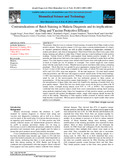Contraindications of Batch Staining in Malaria Diagnosis and its implications on Drug and Vaccine Protective Efficacy
Date
2013-05-13Author
Osoga, Joseph
Obare, Peter
Odera, James Sande
Ogutu, Bernhard’s
Nanakorn, Ampon
Okoth, Patrick
Ohrt, Colin
Metadata
Show full item recordAbstract
The primary objective was to evaluate if batch staining of malaria blood films results in false
positive smears. False positive smears (>1%) may cause a serious underestimate of a drug’s
or vaccine’s protective efficacy, as well as affect evaluation of diagnostics, estimates of
malaria prevalence, and clinical management. Thick blood films may float from a glass slide
during staining and adhere to other films if batch staining is used resulting in false positive
readings. Venous blood in EDTA anticoagulant from malaria positive samples of 20
parasites per high power field and a true negative sample was utilized to make thick and thin
smears. Two true negative smears were stained with Giemsa stain with eight positive smears
in batch in Coplin jars for 10 minutes or overnight. Two control negatives were stained
alone with the same batch of stain. Blinded microscopists read these slides using a rereading
paradigm. Thick film loss was graded by gross appearance ranging from 0 (none) to 4+ (>
¾ loss). A total of 602 slides were evaluated in this study, of which 392 were true positives
(65%) and 210 (35%) were true negatives. Of the true negatives, 110 were batch stained
with true positives, and 100 were true negative controls stained alone. Of the initial readings,
11-20% were reported as falsely positive. “Fishing” or cross-contamination was infrequently
noted by one of the microscopists, but was uniformly present in these smears on
reexamination. Of the true positive smears (high density), 1-3% were read falsely negative.
On reexamination of these slides, the cause was found to be reporting of results from very
poor quality smears. Thick film loss was clearly more severe for the positive slides with 10
minute versus overnight drying (means score 0.97 vs 1.97, p <0.001). This experiment
confirmed that false positive smears result from cross-contamination during batch staining
using methods employed today. Since low frequencies of false positive smears can adversely
impact research and product development results, single slide staining should become the
norm in this setting. Reporting of false negative results occurred in malaria smears with
high densities of parasites. Microscopists should be trained not to report results when smear
quality is not adequate.
URI
https://d1wqtxts1xzle7.cloudfront.net/92923132/1368785951_58_202013_2014882-14885-libre.pdf?1666551769=&response-content-disposition=inline%3B+filename%3DContraindications_of_Batch_Staining_in_M.pdf&Expires=1696851126&Signature=dE4mT9QQ3kzb9VFE3sPXRxd-s3Wb9ZKk3kiyiGscIIkeFR7th0vz1g71lgJ85xK1L4HFmzslq2y5FOxyRFgcORhwYT5XnzZ5dLDPDLJrx1Tn7QFxGyNFPzcuWiNZHh8H0N536e9g4hT6~8WRm4gtEfFpzymR8pivyF9o-H~GgCFDqgelCpyYZsnYyEAaUZB8OY5v9avwDzeS0uGfNId6Ju15REdAyUoI9Ks2ODL~CoU8XuUrj-wHsioy5XrPDk5-c21Qohnx4WiwShuT-L1IXH679iRORAVxn6n60wdVsOhr99KmSduWn7dnBigClMnrFI9K7Aj1SPWaISLYHaXCSw__&Key-Pair-Id=APKAJLOHF5GGSLRBV4ZAhttp://ir-library.mmust.ac.ke:8080/xmlui/handle/123456789/2361
Collections
- Journal Articles [411]

